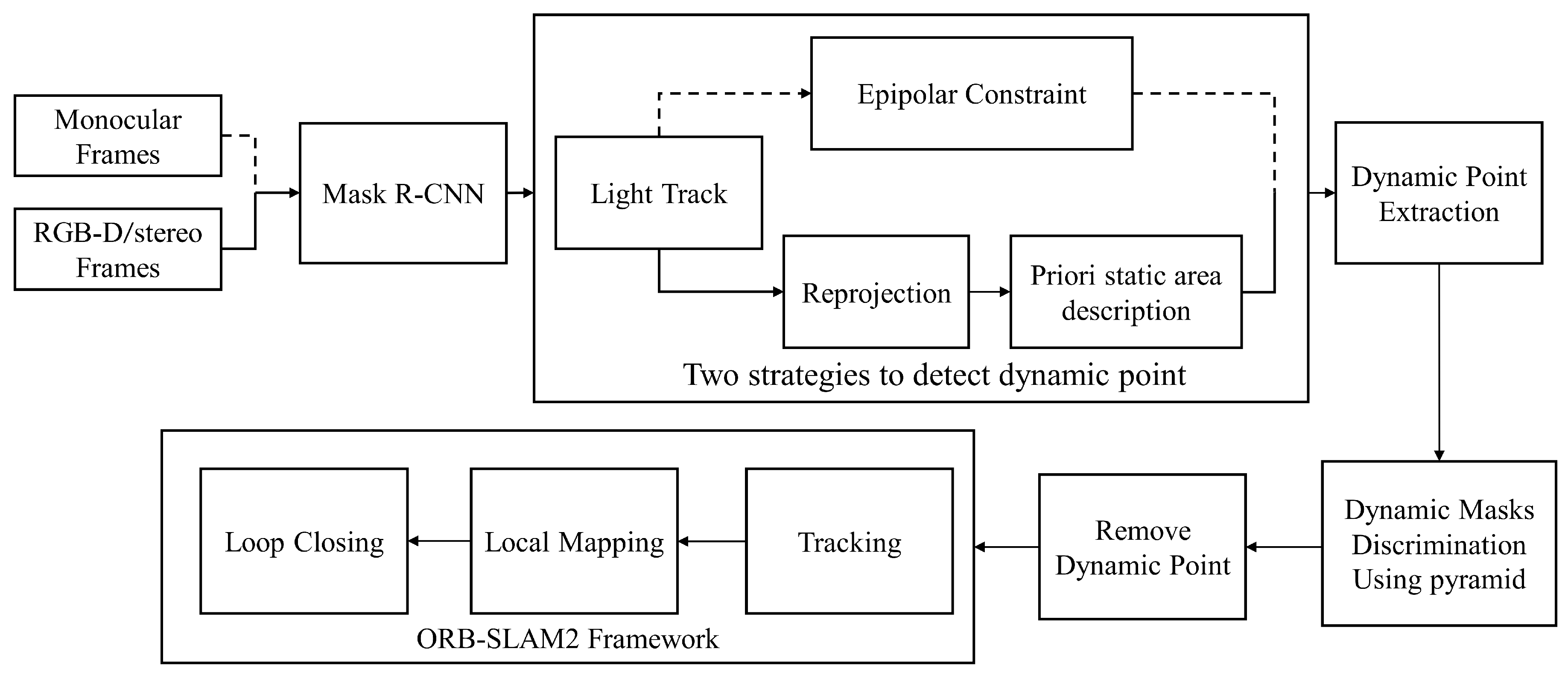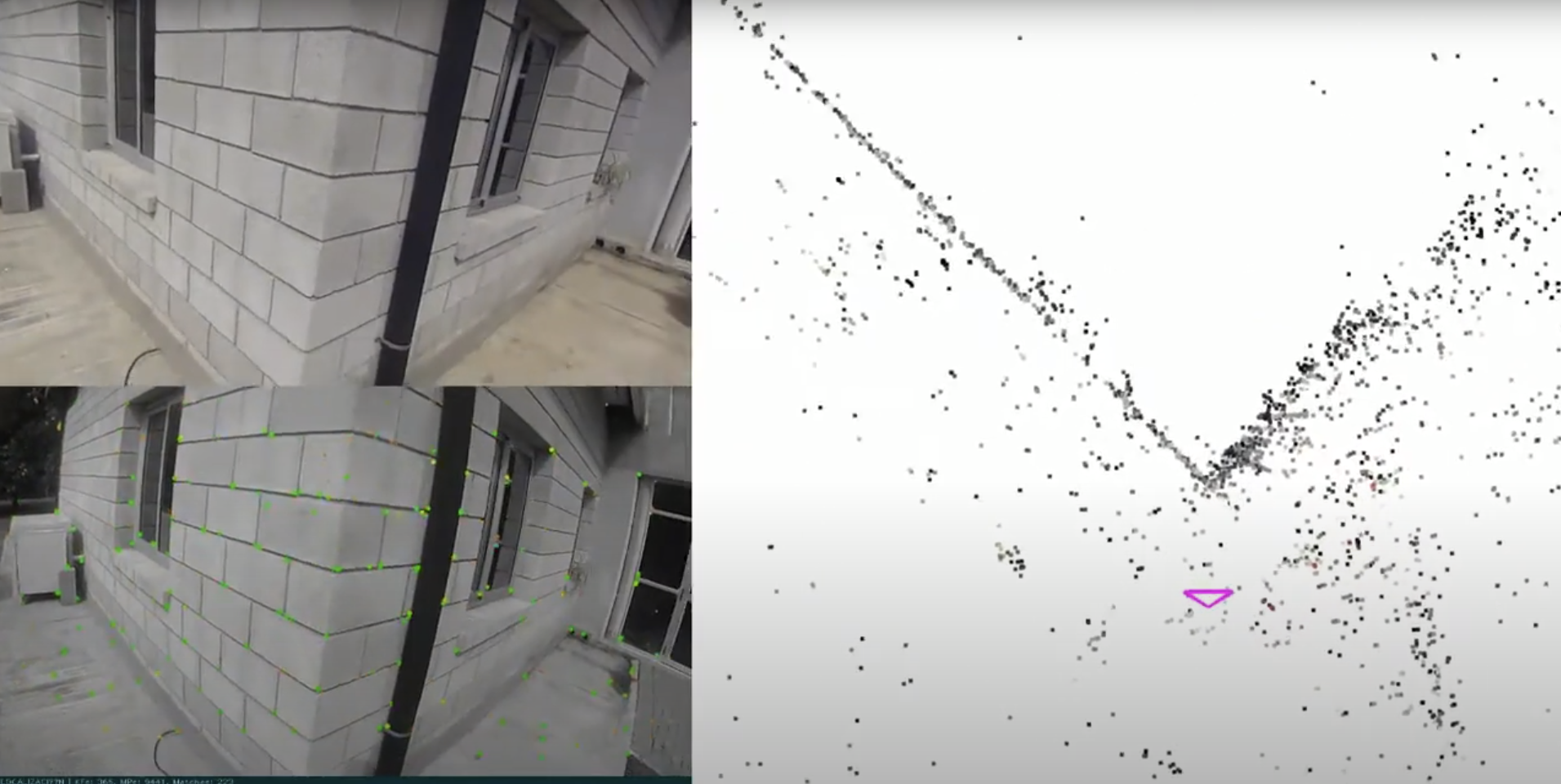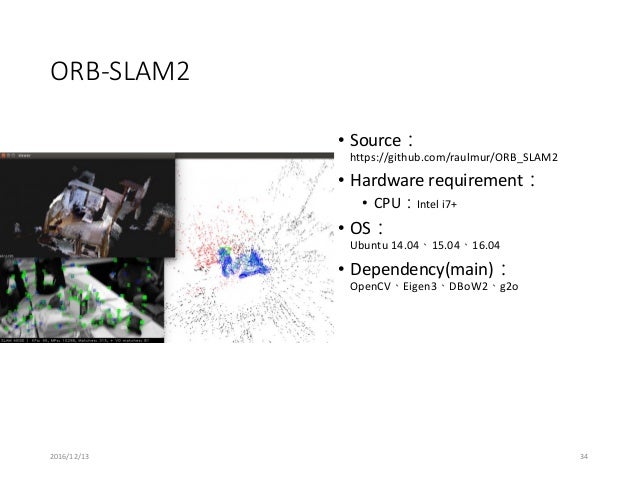
Reimplement 'Fast corner detection' and 'ORB feature extraction' with CUDA. Pipeline GPU kernels as much as possible. Overlap unparallelizable CPU work and GPU work as much as possible. Results Platforms: PC (Xeon E3 1231 / GTX 760 Kepler) TX1 devboard (ARM A57 / 256 core Maxwell) Mean tracking time per frame Mean and peak fps Speedups End. Oct 10, 2017 ORB-SLAM2 is a real-time SLAM library for Monocular, Stereo and RGB-D cameras that computes the camera trajectory and a sparse 3D reconstruction (in the stereo and RGB-D case with true scale). It is able to detect loops and relocalize the camera in real time. 13 where u i isafeaturepoint, P i isascenepoint, ˜istheHuber costfunctionand ∑ isthecovariancematrix. 5 Eeiea er ToevaluateLK-ORB-SLAM2,weperformedexperiments. We port ORBSLAM2(Unity Editor for inside-out tracking in AR/VR senaroi.source code could be found here:https://githu. Abstract: We present ORB-SLAM2, a complete simultaneous localization and mapping (SLAM) system for monocular, stereo and RGB-D cameras, including map reuse, loop closing, and relocalization capabilities.
Jenkins jobs (1)
ORB SLAM2 ros implementation.
- Maintainer status: maintained
- Maintainer: Lennart Haller <haller AT unternehmertum DOT de>
- Author:
- License: GPLv3
- Source: git https://github.com/appliedAI-Initiative/orb_slam_2_ros.git (branch: master)
Jenkins jobs (1)
ORB SLAM2 ros implementation.
- Maintainer status: maintained
- Maintainer: Lennart Haller <haller AT unternehmertum DOT de>
- Author:
- License: GPLv3
- Source: git https://github.com/appliedAI-Initiative/orb_slam_2_ros.git (branch: master)
Contents
- ORB-SLAM2 ROS node
- ROS parameters, topics and services
ORB-SLAM2 Authors:RaulMur-Artal,JuanD.Tardos, J.M.M.Montiel and DorianGalvez-Lopez (DBoW2). The original implementation can be found here.
This is a ROS implementation of the ORB-SLAM2 real-time SLAM library for Monocular, Stereo and RGB-D cameras that computes the camera trajectory and a sparse 3D reconstruction (in the stereo and RGB-D case with true scale). It is able to detect loops and relocalize the camera in real time. This implementation removes the Pangolin dependency, and the original viewer. All data I/O is handled via ROS topics. For vizualization you can use RViz.
Features
- Full ROS compatibility
- Supports a lot of cameras out of the box, such as the Intel RealSense family. See the run section for a list
- Data I/O via ROS topics
- Parameters can be set with the rqt_reconfigure gui during runtime
- Very quick startup through considerably sped up vocab file loading
- Full Map save and load functionality
ROS parameters, topics and services
Parameters
There are three types of parameters right now: static- and dynamic ros parameters and camera settings from the config file. The static parameters are send to the ROS parameter server at startup and are not supposed to change. They are set in the launch files which are located at ros/launch. The parameters are:
- load_map: Bool. If set to true, the node will try to load the map provided with map_file at startup.
- map_file: String. The name of the file the map is saved at.
- settings_file: String. The location of config file mentioned above.
- voc_file:String. The location of config vocanulary file mentioned above.
- publish_pose: Bool. If a PoseStamped message should be published. Even if this is false the tf will still be published.
- publish_pointcloud: Bool. If the pointcloud containing all key points (the map) should be published.
- pointcloud_frame_id: String. The Frame id of the Pointcloud/map.
- camera_frame_id: String. The Frame id of the camera position.
Dynamic parameters can be changed at runtime. Either by updating them directly via the command line or by using rqt_reconfigure which is the recommended way. The parameters are:
- localize_only: Bool. Toggle from/to only localization. The SLAM will then no longer add no new points to the map.
- reset_map: Bool. Set to true to erase the map and start new. After reset the parameter will automatically update back to false.
- min_num_kf_in_map: Int. Number of key frames a map has to have to not get reset after tracking is lost.
Finally, the intrinsic camera calibration parameters along with some hyperparameters can be found in the specific yaml files in orb_slam2/config.


Published topics

The following topics are being published and subscribed to by the nodes:
- All nodes publish (given the settings) a PointCloud2 containing all key points of the map.
- Live image from the camera containing the currently found key points and a status text.
- A tf from the pointcloud frame id to the camera frame id (the position).
Subscribed topics
- The mono node subscribes to /camera/image_raw for the input image.
- The RGBD node subscribes to /camera/rgb/image_raw for the RGB image and
- /camera/depth_registered/image_raw for the depth information.
- The stereo node subscribes to image_left/image_color_rect and
- image_right/image_color_rect for corresponding images.
Services
All nodes offer the possibility to save the map via the service node_type/save_map. So the save_map services are:
- /orb_slam2_rgbd/save_map
- /orb_slam2_mono/save_map
Orb Slam2 Ros
- /orb_slam2_stereo/save_map